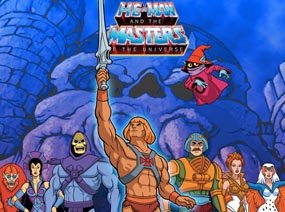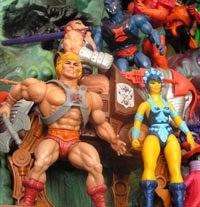Fantasy’s Finest: He-Man and the Masters of the Universe
August 21st, 2009 | Fantasy, Television

The inclusion of “He-Man and the Masters of the Universe” as being among fantasy’s finest might raise some eyebrows, but behind the cheesy 80’s cartoon lies a truly inspired concept. When first considering the world of He-Man, we immediately think of a standard fantasy world involving sword and sorcery, forgetting sometimes that MOTU was just as much sci-fi as it was fantasy. Vehicles flew alongside dragons, blasts from laser pistols were deflected by magic swords, and the evil wizard Skeletor used often employed hovering robots as his muscle. Surprisingly this mishmash of magic and science worked very well. The series always weighed heavily in favor of fantasy, but embracing technology into the mythos made room any story the writers could dream up.
Central to the story is lazy Prince Adam who, with the aid of his magic sword, can become the heroic He-Man. It’s Clark Kent/Superman meets Conan really, although the idea is improved upon by Adam bring vulnerable when not powered up as his alter ego. This much needed weakness adds tension and allows for a sense of danger. He-Man’s closest friend and sidekick is Cringer, a giant talking cat. This is a concept very close to my heart. The two main characters of my book, The Cat in the Cradle, just happen to be a boy and his talking cat. The similarities end there, but I’ve always been aware that I was drawing inspiration from my favorite childhood show.

Masters of the Universe was fairly progressive with its portrayal of strong, female characters. Teela was captain of the royal guard and could hold her own in battle. On the villain’s side, second in command went to witchy Evil-Lyn, one of the only competent members. Likewise, the Sorceress was used in place of the wise old wizard archetype, and was keeper of the most powerful magical secrets. Minorities weren’t as well represented in the cartoon, probably because not many characters were actually human. A scaly merman, a flying bird guy, a humanoid skunk, a robot with a heart, a blue guy with mechanical arms, even a man made of moss. Almost every character was a different type of species or creature, mostly due to the toy line that powered the cartoon. Commercialism aside, the variety of action figures made for a diverse and interesting cast.

The 80s version of the cartoon leaves a lot to be desired. Its frequent reuse of stock animation, public service announcements, and plots aimed low at child audiences of days gone by makes it hard to digest today. Luckily there was a new version of the show in 2004 that fully realized the story’s potential. The somewhat jumbled nature of the 80s concept was reined in and given order, the plots were intelligent with long reaching story arcs, and the action sequences had you on the edge of your seat. Sadly the toy line, the lifeblood of any cartoon, was mismanaged and ended the show prematurely. The two seasons that did air stand as a proud testament to just how excellent and exciting the world of Masters of the Universe can be.
